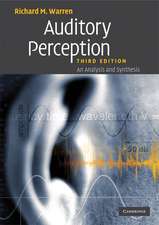Neural Mechanisms in Behavior: A Texas Symposium
Autor H.B. Barlow Editat de D. McFadden Autor R.M. Boynton, E.V. Evarts, E.R. Kandel, F. Ratliff, J.E. Rose, R.F. Thompsonen Limba Engleză Paperback – 10 oct 2011
Preț: 617.08 lei
Preț vechi: 725.97 lei
-15% Nou
Puncte Express: 926
Preț estimativ în valută:
109.20€ • 128.04$ • 95.90£
109.20€ • 128.04$ • 95.90£
Carte tipărită la comandă
Livrare economică 09-23 februarie 26
Preluare comenzi: 021 569.72.76
Specificații
ISBN-13: 9781461260653
ISBN-10: 1461260655
Pagini: 324
Ilustrații: 308 p.
Dimensiuni: 155 x 235 x 17 mm
Greutate: 0.46 kg
Ediția:Softcover reprint of the original 1st ed. 1980
Editura: Springer
Colecția Springer
Locul publicării:New York, NY, United States
ISBN-10: 1461260655
Pagini: 324
Ilustrații: 308 p.
Dimensiuni: 155 x 235 x 17 mm
Greutate: 0.46 kg
Ediția:Softcover reprint of the original 1st ed. 1980
Editura: Springer
Colecția Springer
Locul publicării:New York, NY, United States
Public țintă
ResearchCuprins
1 Neural Correlates of Some Psychoacoustic Experiences.- 2 Design for an Eye.- 3 Form and Function: Linear and Nonlinear Analyses of Neural Networks in the Visual System.- 4 Cortical Function: A Tentative Theory and Preliminary Tests.- 5 The Search for the Engram, II.- 6 Brain Mechanisms in Voluntary Movement.- 7 Cellular Insights into the Multivariant Nature of Arousal.- General Discussion.












